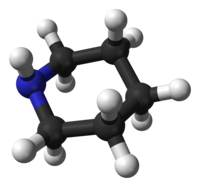| |||

| |||
| Names | |||
|---|---|---|---|
|
IUPAC name
Piperidine
| |||
|
Preferred IUPAC name
Piperidine
[2] | |||
| Other names
Hexahydropyridine
Azacyclohexane Pentamethyleneamine Azinane | |||
| Identifiers | |||
3D model (
JSmol)
|
|||
| ChEBI | |||
| ChEMBL | |||
| ChemSpider | |||
| ECHA InfoCard | 100.003.467 | ||
| EC Number |
| ||
| KEGG | |||
PubChem
CID
|
|||
| RTECS number |
| ||
| UNII | |||
| UN number | 2401 | ||
CompTox Dashboard (
EPA)
|
|||
| |||
| |||
| Properties | |||
| C5H11N | |||
| Molar mass | 85.150 g·mol−1 | ||
| Appearance | Colorless liquid | ||
| Odor | Semen-like, [3] fishy-ammoniacal, pungent | ||
| Density | 0.862 g/mL | ||
| Melting point | −7 °C (19 °F; 266 K) | ||
| Boiling point | 106 °C (223 °F; 379 K) | ||
| Miscible | |||
| Acidity (pKa) | 11.22 (protonated) [4] | ||
| -64.2·10−6 cm3/mol | |||
| Viscosity | 1.573 cP at 25 °C | ||
| Hazards | |||
| GHS labelling: | |||



| |||
| Danger | |||
| H225, H311, H314, H331 | |||
| P210, P233, P240, P241, P242, P243, P260, P261, P264, P271, P280, P301+P330+P331, P302+P352, P303+P361+P353, P304+P340, P305+P351+P338, P310, P311, P312, P321, P322, P361, P363, P370+P378, P403+P233, P403+P235, P405, P501 | |||
| NFPA 704 (fire diamond) | |||
| Safety data sheet (SDS) | MSDS1 | ||
| Legal status | |||
| Related compounds | |||
Related compounds
|
Pyridine Pyrrolidine Piperazine Phosphorinane Arsinane | ||
Except where otherwise noted, data are given for materials in their
standard state (at 25 °C [77 °F], 100 kPa).
| |||
Piperidine is an organic compound with the molecular formula (CH2)5NH. This heterocyclic amine consists of a six-membered ring containing five methylene bridges (–CH2–) and one amine bridge (–NH–). It is a colorless liquid with an odor described as objectionable, typical of amines. [6] The name comes from the genus name Piper, which is the Latin word for pepper. [7] Although piperidine is a common organic compound, it is best known as a representative structure element within many pharmaceuticals and alkaloids, such as natural-occurring solenopsins. [8]
Production
Piperidine was first reported in 1850 by the Scottish chemist Thomas Anderson and again, independently, in 1852 by the French chemist Auguste Cahours, who named it. [9] [10] [11] Both of them obtained piperidine by reacting piperine with nitric acid.
Industrially, piperidine is produced by the hydrogenation of pyridine, usually over a molybdenum disulfide catalyst: [12]
- C5H5N + 3 H2 → C5H10NH
Pyridine can also be reduced to piperidine via a modified Birch reduction using sodium in ethanol. [13]
Natural occurrence of piperidine and derivatives
Piperidine itself has been obtained from black pepper, [14] [15] from Psilocaulon absimile ( Aizoaceae), [16] and in Petrosimonia monandra. [17]
The piperidine structural motif is present in numerous natural alkaloids. These include piperine, which gives black pepper its spicy taste. This gave the compound its name. Other examples are the fire ant toxin solenopsin, [18] the nicotine analog anabasine of tree tobacco ( Nicotiana glauca), lobeline of Indian tobacco, and the toxic alkaloid coniine from poison hemlock, which was used to put Socrates to death. [19]
Conformation
Piperidine prefers a chair conformation, similar to cyclohexane. Unlike cyclohexane, piperidine has two distinguishable chair conformations: one with the N–H bond in an axial position, and the other in an equatorial position. After much controversy during the 1950s–1970s, the equatorial conformation was found to be more stable by 0.72 kcal/mol in the gas phase. [20] In nonpolar solvents, a range between 0.2 and 0.6 kcal/mol has been estimated, but in polar solvents the axial conformer may be more stable. [21] The two conformers interconvert rapidly through nitrogen inversion; the free energy activation barrier for this process, estimated at 6.1 kcal/mol, is substantially lower than the 10.4 kcal/mol for ring inversion. [22] In the case of N-methylpiperidine, the equatorial conformation is preferred by 3.16 kcal/mol, [20] which is much larger than the preference in methylcyclohexane, 1.74 kcal/mol.
 |

|
| axial conformation | equatorial conformation |
Reactions
Piperidine is widely used to convert ketones to enamines. [23] Enamines derived from piperidine are substrates in the Stork enamine alkylation reaction. [24]
Upon treatment with calcium hypochlorite, piperidine converts to N-chloropiperidine, a chloramine with the formula C5H10NCl. The resulting chloramine undergoes dehydrohalogenation to afford the cyclic imine. [25]
NMR chemical control
- 13C NMR: ( CDCl3, ppm) 47, 27.2, 25.2[ citation needed]
- 1H NMR: (CDCl3, ppm) 2.79, 2.19, 1.51[ citation needed]
Uses
Piperidine is used as a solvent and as a base. The same is true for certain derivatives: N-formylpiperidine is a polar aprotic solvent with better hydrocarbon solubility than other amide solvents, and 2,2,6,6-tetramethylpiperidine is a highly sterically hindered base, useful because of its low nucleophilicity and high solubility in organic solvents.
A significant industrial application of piperidine is for the production of dipiperidinyl dithiuram tetrasulfide, which is used as an accelerator of the sulfur vulcanization of rubber. [12]
List of piperidine medications

Piperidine and its derivatives are ubiquitous building blocks in pharmaceuticals [26] and fine chemicals. The piperidine structure is found in, for example:
- Icaridin (Insect repellent)
- SSRIs ( selective serotonin reuptake inhibitors)
- Stimulants and nootropics:
- Histamine 1 (H1) receptor antagonists/inverse agonists:
- Histamine 3 (H3) receptor antagonists/ inverse agonists:
- SERM ( selective estrogen receptor modulators)
- Vasodilators
- Antipsychotic medications:
-
Opioids:
- Dipipanone
- Fentanyl and analogs
- Loperamide
- Pethidine (meperidine)
- Prodine
-
Arylcyclohexylamines:
- PCP and analogs
-
anticholinergic
chemical weapons
- Ditran
- N-Methyl-3-piperidyl benzilate (JB-336, BZ)
Piperidine is also commonly used in chemical degradation reactions, such as the sequencing of DNA in the cleavage of particular modified nucleotides. Piperidine is also commonly used as a base for the deprotection of Fmoc- amino acids used in solid-phase peptide synthesis.
Piperidine is listed as a Table II precursor under the United Nations Convention Against Illicit Traffic in Narcotic Drugs and Psychotropic Substances due to its use (peaking in the 1970s) in the clandestine manufacture of phencyclidine. [27]
References
- ^ "International Chemical Safety Card 0317". 28 January 2024.
-
^ "Front Matter". Nomenclature of Organic Chemistry : IUPAC Recommendations and Preferred Names 2013 (Blue Book). Cambridge:
The Royal Society of Chemistry. 2014. p. 142.
doi:
10.1039/9781849733069-FP001 (inactive 2024-06-30).
ISBN
978-0-85404-182-4.
{{ cite book}}: CS1 maint: DOI inactive as of June 2024 ( link) - ^ Amoore, J. E. (1975). "Specific anosmia to 1-pyrroline: The spermous primary odor". J. Chem. Ecol. 1 (3): 299–310. Bibcode: 1975JCEco...1..299A. doi: 10.1007/BF00988831. S2CID 19318345.
- ^ Hall, H. K. (1957). "Correlation of the Base Strengths of Amines". J. Am. Chem. Soc. 79 (20): 5441–5444. doi: 10.1021/ja01577a030.
- ^ Anvisa (2023-03-31). "RDC Nº 784 - Listas de Substâncias Entorpecentes, Psicotrópicas, Precursoras e Outras sob Controle Especial" [Collegiate Board Resolution No. 784 - Lists of Narcotic, Psychotropic, Precursor, and Other Substances under Special Control] (in Brazilian Portuguese). Diário Oficial da União (published 2023-04-04). Archived from the original on 2023-08-03. Retrieved 2023-08-15.
- ^ Frank Johnson Welcher (1947). Organic Analytical Reagents. D. Van Nostrand. p. 149.
- ^ Senning, Alexander (2006). Elsevier's Dictionary of Chemoetymology. Amsterdam: Elsevier. ISBN 978-0-444-52239-9.
- ^ Pianaro, Adriana; Fox, Eduardo G.P.; Bueno, Odair C.; Marsaioli, Anita J. (May 2012). "Rapid configuration analysis of the solenopsins". Tetrahedron: Asymmetry. 23 (9): 635–642. doi: 10.1016/j.tetasy.2012.05.005.
-
^ Warnhoff, Edgar W. (1998).
"When piperidine was a structural problem" (PDF). Bulletin for the History of Chemistry. 22: 29–34.

-
^
Anderson, Thomas (1850).
"Vorläufiger Bericht über die Wirkung der Salpetersäure auf organische Alkalien" [Preliminary report on the effect of nitric acid on organic alkalis]. Annalen der Chemie und Pharmacie. 75: 80–83.
doi:
10.1002/jlac.18500750110.

-
^
Cahours, Auguste (1852).
"Recherches sur un nouvel alcali dérivé de la pipérine" [Investigations of a new alkali derived from piperine]. Comptes Rendus. 34: 481–484.
L'alcali nouveau dérivé de la pipérine, que je désignerai sous le nom de 'pipéridine',… (The new alkali derived from piperine, which I will designate by the name of 'piperidine',…

- ^ a b Eller, Karsten; Henkes, Erhard; Rossbacher, Roland; Höke, Hartmut. "Amines, Aliphatic". Ullmann's Encyclopedia of Industrial Chemistry. Weinheim: Wiley-VCH. doi: 10.1002/14356007.a02_001. ISBN 978-3527306732.
- ^ Marvel, C. S.; Lazier, W. A. (1929). "Benzoyl Piperidine". Org. Synth. 9: 16. doi: 10.15227/orgsyn.009.0016.
- ^ Späth; Englaender (1935). "Über das Vorkommen von Piperidin im schwarzen Pfeffer". Chemische Berichte. 68 (12): 2218–2221. doi: 10.1002/cber.19350681211.
- ^ Pictet, Amé; Pictet, René (1927). "Sur l'alcaloïde volatil du poivre". Helvetica Chimica Acta. 10: 593–595. doi: 10.1002/hlca.19270100175.
- ^ Rimington, Claude (1934). "Psilocaulon absimile N.E.Br. as a stock poison". South African Journal of Science. 31: 184–193. hdl: 10520/AJA00382353_6425.
-
^ Juraschewski; Stepanov (1939). J. Gen. Chem. USSR. 9: 1687.
{{ cite journal}}: Missing or empty|title=( help) - ^ Arbiser, J. L.; Kau, T.; Konar, M.; et al. (2007). "Solenopsin, the alkaloidal component of the fire ant (Solenopsis invicta), is a naturally occurring inhibitor of phosphatidylinositol-3-kinase signaling and angiogenesis". Blood. 109 (2): 560–5. doi: 10.1182/blood-2006-06-029934. PMC 1785094. PMID 16990598.
- ^ Thomas Anderson Henry (1949). The Plant Alkaloids (4th ed.). The Blakiston Company.
- ^ a b Carballeira, Luis; Pérez Juste, Ignacio (1998). "Influence of calculation level and effect of methylation on axial/equatorial equilibria in piperidines". Journal of Computational Chemistry. 19 (8): 961–976. doi: 10.1002/(SICI)1096-987X(199806)19:8<961::AID-JCC14>3.0.CO;2-A. S2CID 98028598.
- ^ Blackburne, Ian D.; Katritzky, Alan R.; Yoshito Takeuchi (1975). "Conformation of piperidine and of derivatives with additional ring hetero atoms". Acc. Chem. Res. 8 (9): 300–306. doi: 10.1021/ar50093a003.
- ^ Anet, F. A. L.; Yavari, Issa (1977). "Nitrogen inversion in piperidine". J. Am. Chem. Soc. 99 (8): 2794–2796. doi: 10.1021/ja00450a064.
- ^ Kane, Vinayak V.; Jones, Maitland Jr. (1990). "Spiro[5.7]trideca-1,4-dien-3-one". Organic Syntheses; Collected Volumes, vol. 7, p. 473.
- ^ Smith, Michael B.; March, Jerry (2001). March's Advanced Organic Chemistry: Reactions, Mechanisms, and Structure (5th ed.). Wiley-Interscience. ISBN 978-0-471-58589-3.
- ^ Claxton, George P.; Allen, Lloyd; Grisar, J. Martin (1977). "2,3,4,5-Tetrahydropyridine Trimer". Organic Syntheses. 56: 118. doi: 10.15227/orgsyn.056.0118.
- ^ Vitaku, E.; D. T. Smith; J. T. Njardarson (2014). "Analysis of the Structural Diversity, Substitution Patterns, and Frequency of Nitrogen Heterocycles among U.S. FDA Approved Pharmaceuticals". Journal of Medicinal Chemistry. 57 (24): 10257–10274. doi: 10.1021/jm501100b. PMID 25255204.
- ^ "List of Precursors and Chemicals Frequently Used in the Illicit Manufacture of Narcotic Drugs and Psychotropic Substances Under International Control" (PDF). International Narcotics Control Board. Archived from the original (PDF) on 2008-02-27.
External links
-
 Media related to
Piperidine at Wikimedia Commons
Media related to
Piperidine at Wikimedia Commons


